How system integration in retail solves issues with inventory management
- June 25
- 5 min

An enterprise service bus (ESB) serves as a software architecture pattern that acts as the connective tissue between disparate applications across an organization. Think of it as the central nervous system of an enterprise’s IT infrastructure—a communication backbone that lets systems talk to each other regardless of their underlying technologies, protocols, or programming languages.
ESBs emerged in the early 2000s as a practical solution to the integration headaches plaguing organizations adopting service-oriented architecture (SOA). Rather than creating a tangled web of point-to-point connections between systems (which quickly becomes a maintenance nightmare), an ESB implements a hub-and-spoke model where all applications connect to a central bus that handles all the complex work of routing, transforming, and delivering messages.
At its heart, the ESB addresses a fundamental business problem: how to make diverse IT ecosystems work together smoothly without requiring massive redevelopment efforts. It creates a layer of abstraction that shields applications from the technical details of how they communicate, allowing organizations to focus on business functionality rather than integration plumbing.
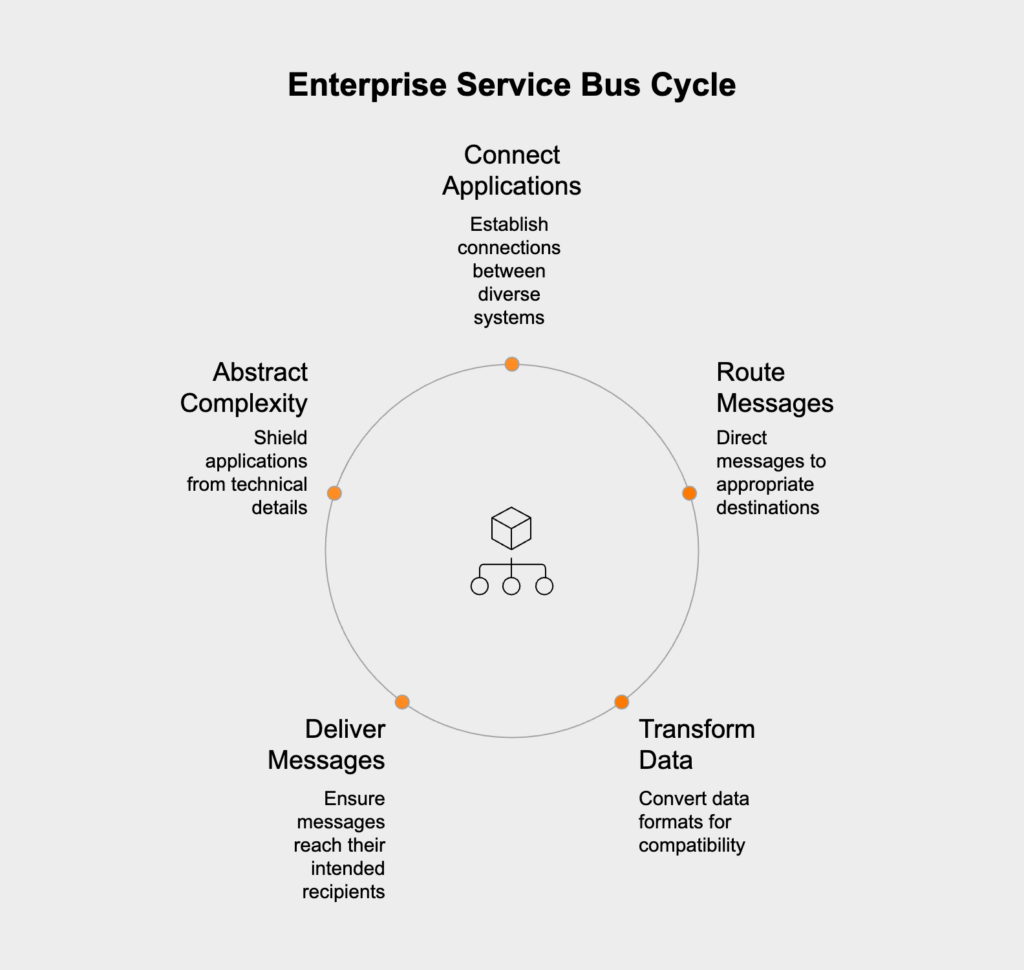
A fully-functioning ESB architecture consists of several critical components working in concert to enable seamless system integration:
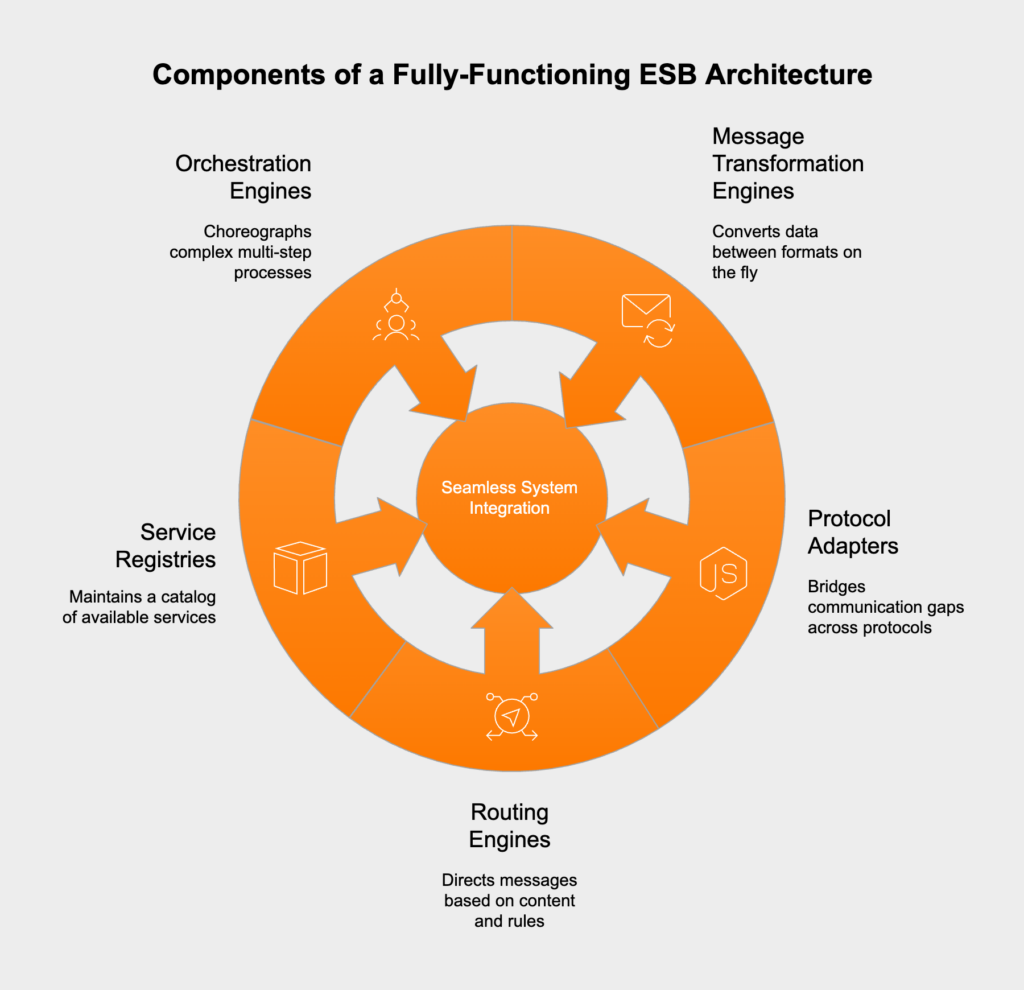
The endpoints function as the doorways through which data enters and exits the ESB. These endpoints expose standardized interfaces that shield applications from the messy details of the systems they’re communicating with. This abstraction is what makes the magic happen—services can exchange information without needing to know anything about each other’s inner workings.
A content-based router acts as the traffic director, examining message content to make smart decisions about where messages should go. This intelligent routing lets the ESB dynamically steer messages based on business context rather than hardcoded paths.
Most modern ESBs also incorporate a message repository that keeps a record of messages flowing through the system. This repository isn’t just for recordkeeping—it enables crucial capabilities like audit trails, message replay for error recovery, and reliable delivery patterns that ensure messages reach their destination even if systems temporarily fail.
The ESB operates through a well-defined workflow that keeps applications loosely coupled. When System A needs to talk to System B, it doesn’t reach out directly—instead, it simply drops a message onto the bus and lets the ESB handle the rest. The process unfolds like this:
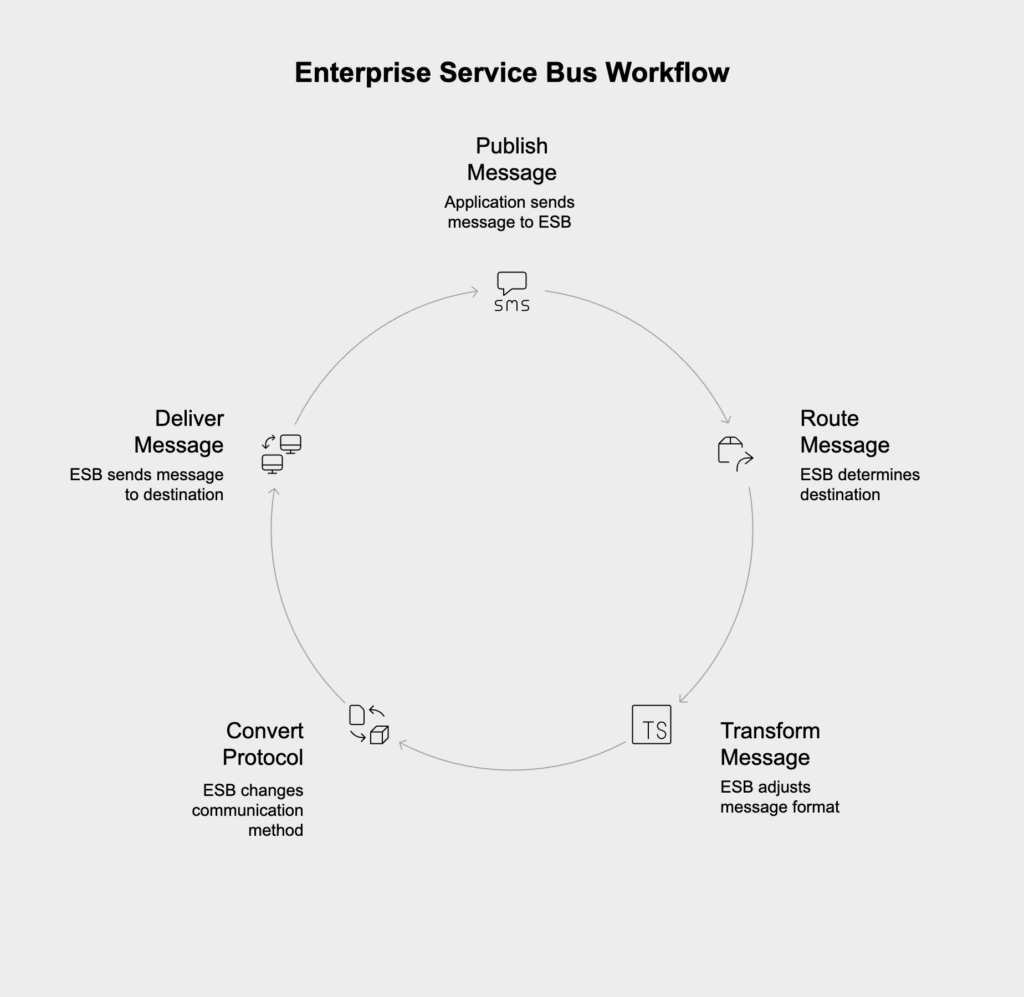
This happens behind the scenes in real-time, largely invisible to the applications themselves. The ESB shoulders all the complex integration work, freeing each application to focus on its core business logic rather than worrying about how to communicate with other systems.
For instance, when a CRM system needs to share updated customer information with an ERP system, it simply sends the data to the ESB in its native format. The ESB handles all the necessary transformations and delivers the data to the ERP in exactly the format it needs. Neither system has to accommodate the other’s technical quirks or requirements.
Message processing is a cornerstone of any ESB’s capabilities. As messages travel through the bus, they may undergo several transformations: Data format transformation converts between different representations like XML or JSON; Protocol transformation allows messages to jump between communication methods like JMS to HTTP; Content enrichment adds context by pulling in additional data from other sources; and message validation ensures that only properly structured data moves through the system, maintaining data integrity across the enterprise.
Organizations adopt enterprise service buses to gain several strategic advantages in their IT operations:
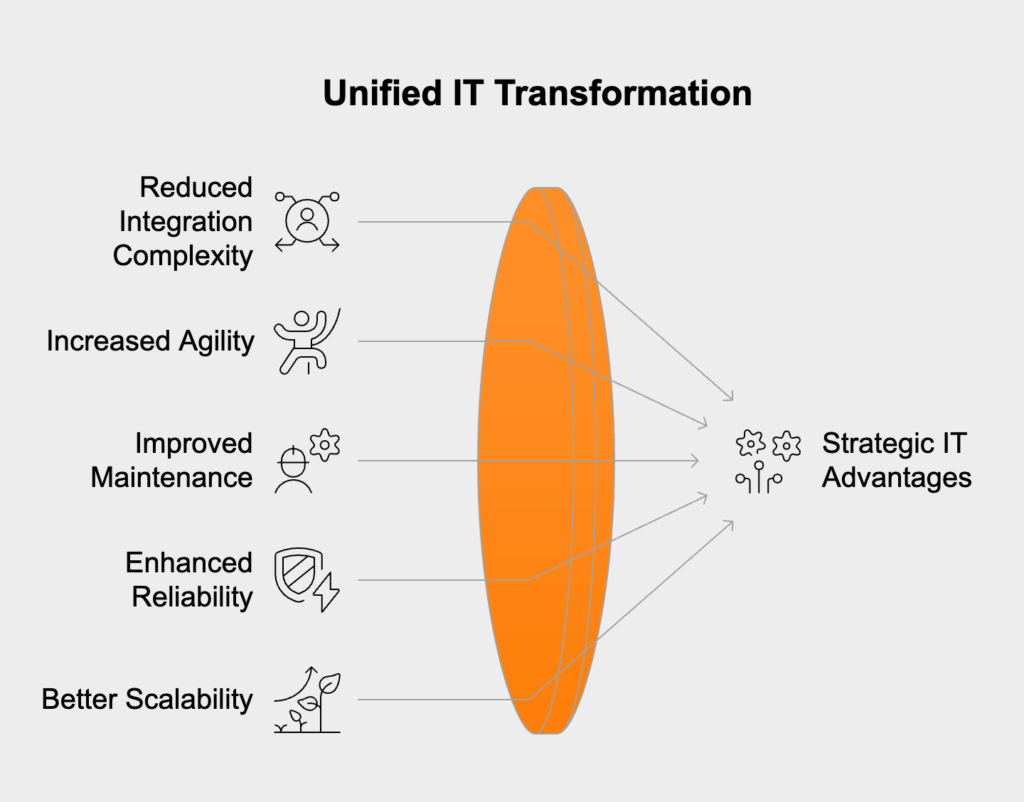
The loose coupling that ESBs provide is particularly valuable in dynamic business environments. When applications connect through an ESB, they don’t need intimate knowledge of each other’s interfaces, locations, or technical details. This separation means you can modify or even completely replace individual systems without sending ripples of disruption through your entire IT ecosystem.
ESBs also enable incremental modernization of technology landscapes. Organizations can gradually introduce new systems while maintaining connections to legacy applications, effectively bridging old and new worlds. This ability to evolve systems at your own pace helps protect existing investments while still enabling digital transformation initiatives.
Enterprise service buses shine in scenarios where complex integration challenges exist across different technology generations and organizational boundaries. One of the most compelling use cases is legacy system integration, where ESBs connect older systems with modern applications. Many organizations rely on mission-critical functions running on aging platforms that lack modern APIs. An ESB can wrap these legacy systems with standardized interfaces, making them accessible to newer applications without expensive rewrites. A bank might use an ESB to connect its mainframe-based core banking system with its mobile app, with the ESB handling all the technical translation work that makes this unlikely pairing possible.
ESBs excel at B2B integration by creating secure, reliable channels for exchanging data with external partners. The ESB manages the complexities of different formats, security requirements, and communication protocols that inevitably arise when connecting with outside organizations. A manufacturer might deploy an ESB to integrate with dozens of supplier systems for automated ordering, with the ESB handling the transformation between internal formats and the various formats used by different suppliers.
While microservices architectures often favor different integration patterns, ESBs can play a valuable role in microservices integration, especially in hybrid environments. An ESB can serve as a bridge between traditional monolithic applications and newer microservices, providing enterprise-wide capabilities like message transformation. A retailer might use microservices for its e-commerce platform while maintaining legacy inventory systems, with an ESB facilitating communication between these architectural styles.
Enterprise service buses represent one approach in a spectrum of integration options, each with distinct characteristics. Compared to point-to-point integration, where direct connections link each pair of communicating systems, ESBs offer a more manageable alternative. The point-to-point approach quickly becomes unwieldy as systems multiply—with n systems, you potentially need n(n-1)/2 connections, creating an integration nightmare. ESBs solve this “spaghetti integration” problem through centralization, though this central hub must be properly designed to avoid becoming a single point of failure.
When comparing ESBs vs. API gateways, the distinction comes down to focus and scope. API gateways primarily manage and secure APIs (typically REST or GraphQL), excelling at exposing services to external consumers with features like rate limiting and developer portals. ESBs cast a wider net, handling diverse integration patterns and protocols, with stronger transformation capabilities and better support for legacy systems. Many organizations use both: API gateways for external-facing services and ESBs for internal integration, particularly where legacy systems are involved.
Integration Platform as a Service (iPaaS) solutions deliver cloud-based integration capabilities similar to ESBs but as managed services. These platforms typically come with pre-built connectors for popular SaaS applications and favor configuration over coding. While traditional ESBs usually live on-premises and require more hands-on management, iPaaS solutions reduce operational overhead by handling infrastructure concerns. The trade-off? ESBs often provide more customization options and better support for complex integration scenarios requiring specialized logic.
Despite their strengths, enterprise service buses come with several challenges that organizations should weigh carefully:
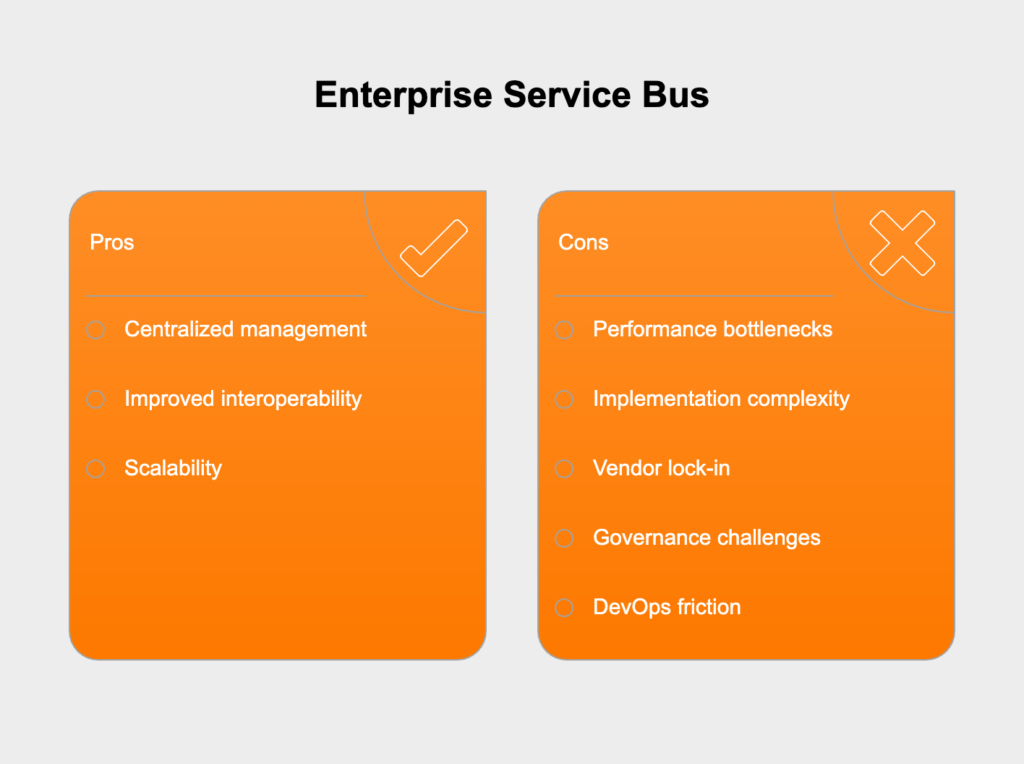
The centralized nature of traditional ESBs can clash with highly distributed architectures. As organizations embrace microservices and cloud-native approaches, the heavyweight, centralized model of an ESB may feel at odds with principles like decentralized governance and independent deployability that drive these modern architectures.
ESBs can also introduce additional latency into system interactions because of the extra processing needed for message transformation and routing. While this overhead is acceptable for many business processes, it might become problematic for applications with strict real-time performance requirements where every millisecond counts.
The ESB pattern hasn’t stood still—it has evolved significantly to address changing technology landscapes and integration needs. Lightweight ESBs have emerged that deliver core integration capabilities without the complexity and overhead of traditional middleware. These streamlined solutions focus on essential functions while shedding unnecessary weight.
Cloud-native integration platforms now offer ESB-like capabilities specifically designed for cloud environments, with containerized deployment options, elastic scaling, and seamless integration with cloud services. The influence of event-driven architectures has also shaped modern ESBs, with many platforms now incorporating robust event processing capabilities that allow systems to react to events rather than relying solely on request-response patterns.
The rise of API-led connectivity has further transformed ESB evolution, with many platforms now blending API management features with traditional ESB capabilities. This hybrid approach helps organizations bridge between integration styles as they modernize their architecture, providing a practical path forward rather than forcing an all-or-nothing choice.
An enterprise service bus makes the most sense in several specific scenarios:
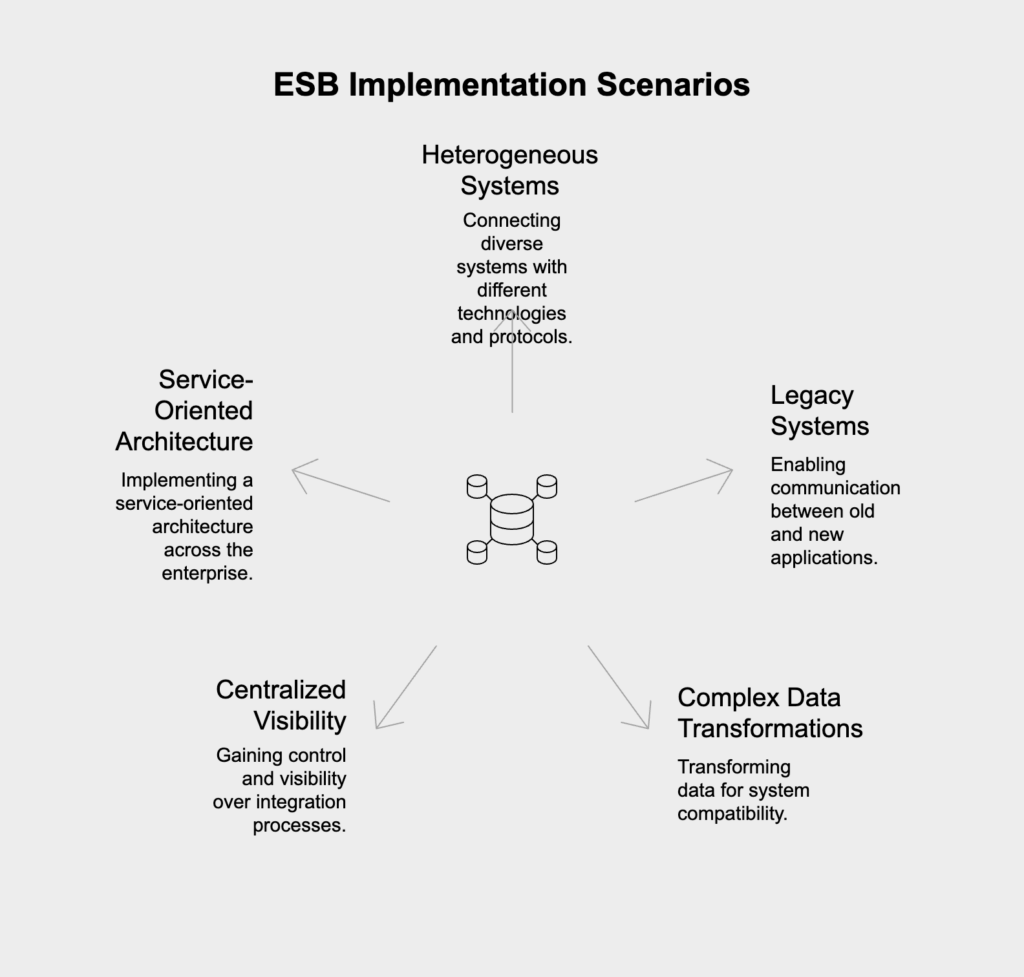
Organizations with complex integration requirements spanning multiple technologies and business domains typically benefit most from an ESB approach. The centralized integration model provides consistency and governance that might be hard to achieve with more decentralized patterns, especially in large enterprises with diverse systems.
However, companies pursuing cloud-native architectures or microservices might find that other integration patterns better align with their goals. In these cases, lightweight messaging systems, API gateways, or service meshes often prove more suitable than traditional ESBs.
The ESB decision shouldn’t just consider today’s integration needs but also your organization’s long-term architectural direction and digital transformation strategy. Many successful organizations take a pragmatic hybrid approach, using ESBs where they make sense while employing other patterns where they offer better fit.
Organizations planning to implement an ESB should address several critical factors to ensure success. Strong governance and standards form the foundation of effective ESB implementation. Without clear guidelines for service definitions, data models, and integration patterns, an ESB can quickly become as chaotic as the point-to-point integrations it was meant to replace. Establishing and enforcing standards helps maintain consistency across the integration landscape.
A comprehensive service registry or catalog is essential for tracking available services and their interfaces. This registry should capture key metadata about each service—its purpose, owner, SLAs, and dependencies. Good documentation ensures that developers can easily discover and understand available services when building new integrations, reducing duplication and promoting reuse.
ESB architectures must be designed with scalability in mind from day one. This applies both to technical infrastructure (processing capacity, throughput) and organizational aspects (governance processes, development practices). Clustering and load balancing capabilities are crucial for ensuring the ESB can handle growing message volumes without becoming a bottleneck. Organizations should also consider how to scale their integration teams and processes as more services join the ecosystem.
As a central integration hub, an ESB handles sensitive data flowing between systems and must incorporate robust security measures:

Security needs to be woven into every layer of the ESB implementation, from network connectivity to message processing to service exposure. The centralized nature of an ESB can actually strengthen your security posture by providing a single point for implementing and enforcing security policies across all integrations, rather than having to secure dozens or hundreds of individual connection points.
